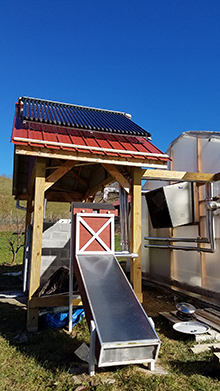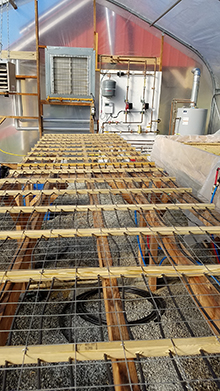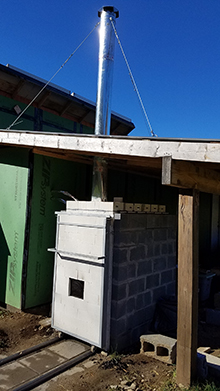The Nexus research team at Appalachian has completed building pilot systems at two local cooperative farms: Against the Grain (ATG) farm and Springhouse farm. They are ready to run for this upcoming cold season!
The pilot system at ATG includes a biochar kiln, solar thermal collector, food dehydrator and thermal battery. The heat from the biochar kiln and solar collector is collected and stored in the thermal battery and will be radiated to the passive greenhouse and to the germination pots sitting on top of the thermal battery at night.
The Springhouse farm has a 20ft. by 30ft. high tunnel greenhouse that includes four growing benches and one germination bench. The Nexus team installed a solar thermal collector, biochar kiln, food dehydrator, and root zone heating system at the Springhouse farm. The collected heat from the solar collector and the biochar kiln is stored in a 50 gallon propane water heater. While the heat is radiated from the thermal battery to the greenhouse space directly at ATG farm, the collected heat is radiated to the soil on the benches through ¼” PE tubing installed under the growing tables at the Springhouse Farm.
It is anticipated that the root zone heating system supported by the pilot system will improve energy efficiency of the overall heating system at the Springhouse farm. A conventional heating system (forced air heater) heats soil by heating the air, which is less economical and efficient than heating the soil directly. Additionally, higher air temperature results in increased heat loss from the greenhouse to outside. Root zone heating usually allows the operator to have a lower nighttime setting temperature by 5 to 10deg F, which results in overall energy cost savings. Another advantage of the root zone heating system is being able to control soil temperature. Several studies have showed that optimal soil temperature for root initiation is higher than required soil temperature for root development.
The biochar kiln is designed to collect waste heat from combustion. Flue gas from the combustion travels the closed space on top of the combustion chamber where the heat exchanger is sitting on before it reaches the chimney. The heat exchanger is ½”- 60ft. copper tubing coil, and 50/50 water-glycol fluid will flow in it and deliver waste heat from the kiln to thermal battery. From the preliminary study, the team discovered that the flue gas temperature at the heat exchanging space could reach up to 500deg F and maintained over 400deg F for 2 hours and over 200deg F for 5 hours. The modeling tool estimates 7,600 BTUs/hr for the heat exchange rate.
During the warm season when heating is not needed, the collected heat will be used to dry food in the food dehydrator. Dried food such as dried apples and sun-dried tomatoes is a good way of food preservation, and can be another source of income for farmers.
The Nexus team will continue working on monitoring, optimizing, and collecting data for the two systems. After observing its operation during the first season, the Nexus team will plan workshops and/or field days to share the results with the community.
 |  |  |
| solar thermal collector and dehydrator | heated bench | biochar kiln |